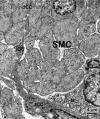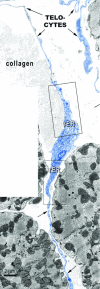TELOCYTES - a case of serendipity: the winding way from Interstitial Cells of Cajal (ICC), via Interstitial Cajal-Like Cells (ICLC) to TELOCYTES
- PMID: 20367664
- PMCID: PMC3823108
- DOI: 10.1111/j.1582-4934.2010.01059.x
TELOCYTES - a case of serendipity: the winding way from Interstitial Cells of Cajal (ICC), via Interstitial Cajal-Like Cells (ICLC) to TELOCYTES
Abstract
Ramon y Cajal discovered a particular cell type in the gut, which he named 'interstitial neurons' more that 100 years ago. In the early 1970s, electron microscopy/electron microscope (EM) studies showed that indeed a special interstitial cell type corresponding to the cells discovered by Cajal is localized in the gut muscle coat, but it became obvious that they were not neurons. Consequently, they were renamed 'interstitial cells of Cajal' (ICC) and considered to be pace-makers for gut motility. For the past 10 years many groups were interested in whether or not ICC are present outside the gastrointestinal tract, and indeed, peculiar interstitial cells were found in: upper and lower urinary tracts, blood vessels, pancreas, male and female reproductive tracts, mammary gland, placenta, and, recently, in the heart as well as in the gut. Such cells, now mostly known as interstitial Cajal-like cells (ICLC), were given different and confusing names. Moreover, ICLC are only apparently similar to canonical ICC. In fact, EM and cell cultures revealed very particular features of ICLC, which unequivocally distinguishes them from ICC and all other interstitial cells: the presence of 2-5 cell body prolongations that are very thin (less than 0.2 mum, under resolving power of light microscopy), extremely long (tens to hundreds of mum), with a moniliform aspect (many dilations along), as well as caveolae. Given the unique dimensions of these prolongations (very long and very thin) and to avoid further confusion with other interstitial cell types (e.g. fibroblast, fibrocyte, fibroblast-like cells, mesenchymal cells), we are proposing the term TELOCYTES for them, and TELOPODES for their prolongations, by using the Greek affix 'telos'.
Figures

















References
-
- Ramon y Cajal S. Histologie du Systeme Nerveux de L’Homme et des Vertebres. Vol. 2. Paris: A. Maloine; 1911.
-
- Faussone Pellegrini MS, Cortesini C, Romagnoli P. Ultrastructure of the tunica muscularis of the cardial portion of the human esophagus and stomach, with special reference to the so-called Cajal’s interstitial cells. Arch Ital Anat Embriol. 1977;82:157–77. - PubMed
-
- Thuneberg L. Interstitial cells of Cajal: intestinal pacemaker cells? Adv Anat Embryol Cell Biol. 1982;71:1–130. - PubMed
-
- Faussone-Pellegrini MS, Thuneberg L. Guide to the identification of interstitial cells of Cajal. Microsc Res Tech. 1999;47:248–66. - PubMed
-
- Faussone-Pellegrini MS. Interstitial cells of Cajal: once negligible players, now blazing protagonists. Ital J Anat Embryol. 2005;110:11–31. - PubMed
Publication types
MeSH terms
LinkOut - more resources
Full Text Sources
Miscellaneous

